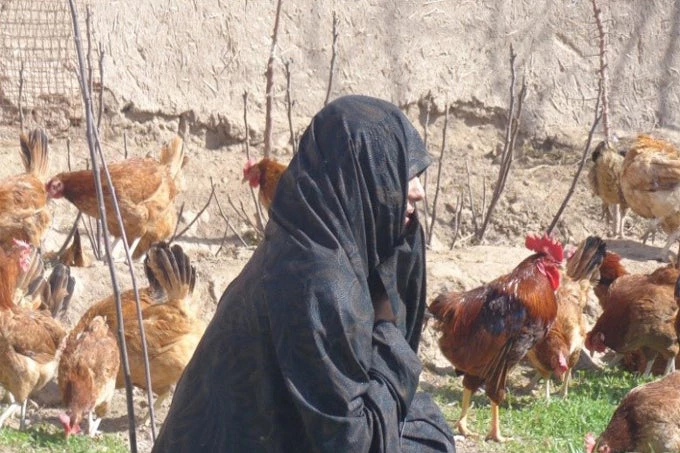
“I was a completely broken person before, a person who was not able to confront the hardship of life,” says Pashtuna, a 32-year-old poultry farmer who lives in the Herat province with her husband and five children.
A beneficiary of the National Horticulture and Livestock Project she decided to attend the Farmers Field School. Upon completion of her training, she received 100 laying hens and access to equipment, feed, and animal vaccines. Pashtuna was able to maintain 80 laying hens and generated a AFN 560 income, half of which she kept to buy poultry food. “Thanks to the poultry farm and the grace of God, I can afford my life and I have a bright vision for my family future,” she says.
Revitalizing agriculture and creating agriculture jobs is a priority for the Government of Afghanistan and the World Bank Group as the sector can play an important role in reducing poverty and sustaining inclusive growth.
Until the late 1970s, Afghanistan was one of the world’s top producer of horticultural products and supplied 20 percent of the raisins on the global market. The country held a dominant position in pistachio and dried fruit production, and exported livestock and wool products to regional markets.
Unfortunately, decades of conflict destroyed much of Afghanistan’s agricultural infrastructure. The last fifteen years, however, have witnessed positive and inspiring changes in the lives of Afghan farmers, such as Pashtuna.
While focusing on rebuilding infrastructure, reorganizing farming communities and identifying vulnerabilities and opportunities, the Ministry of Agriculture, Irrigation and Livestock (MAIL) has brought new ideas and innovations to the agriculture sector in Afghanistan.
“Over the past five years, important changes in the practice and direction of agriculture have demanded greater expectation on performance and responsiveness of our Ministry, as well as other institutions of the government,” explains Assadullah Zamir, Afghanistan’s Minister of Agriculture, Irrigation and Livestock. “And the demand by women and men farmers, who have discovered the potential of improved methods of growing fruits and vegetables and producing livestock, has been recasting the relationships between MAIL and our clients, the farmers.”
An Impending ‘Youth Bulge’ in Rural Afghanistan will Require New and Better Jobs
Afghanistan’s rural labor force will experience a ‘youth bulge’ in the years to come. About 46 percent of the country’s rural population is under 14 (ALCS 2013-14), and the proportion of people entering the workforce will grow faster in the coming years requiring effective job creation policies.
As noted in the forthcoming economic sector work Jobs from Agriculture in Afghanistan, about half a million extra male young workers and nearly about 160,000 extra female workers will join the workforce by 2018. Yet, while agriculture is a major source of jobs in rural Afghanistan, the sector accounts for about 36 percent of rural income as the majority of agriculture workers are unpaid young adults working in their families’ farms .
This new generation is more literate and skilled than their elders. As a result, the key challenge for policy makers and development practitioners in Afghanistan is to generate new jobs and better jobs. Failure to do so may drive the young generation of workers into frustration and lead the country into further social instability.
The Way Forward: Promoting Better Jobs for the Youth in Agriculture
Agriculture is often seen as an unattractive sector with low returns, especially among young workers. However, in the past years, the Afghan government has increased its support to the private sector and encouraged greater competition and public-private partnerships in agricultural value-chains. This has helped reposition agriculture as a viable and lucrative sector for domestic and international investment in Afghanistan.
Agriculture represents an enormous opportunity for growth and better jobs for young entrepreneurs, especially for those already involved in their families’ farms or agri-businesses. Sub-sectors such as horticulture, high-value cash crops like saffron, dry fruits and nuts, fruit processing, and other value-added products hold abound with opportunities.
However, there is still limited awareness of the long-term benefits of agribusiness among the youth. More systematic and targeted initiatives from the government, donors and private sector can help remove obstacles that stand in the way of doing business in agriculture. Such initiatives could include facilitating access to investment funds to buy machinery and technologies and improving land laws and policies to ease the process of acquiring farming lands.
Equally important is providing the right knowledge and skills and learning from other peers’ successful stories like Pashtuna’s.



Join the Conversation